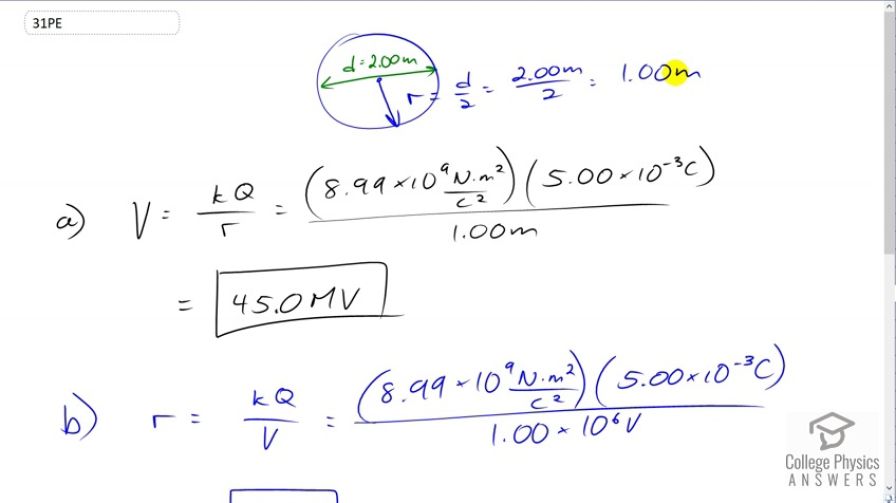Question
A research Van de Graaff generator has a 2.00-m- diameter metal sphere with a charge of 5.00 mC on it. (a) What is the potential near its surface? (b) At what distance from its center is the potential 1.00 MV? (c) An oxygen atom with three missing electrons is released near the Van de Graaff generator. What is its energy in MeV at this distance?
Final Answer
Solution video
OpenStax College Physics for AP® Courses, Chapter 19, Problem 31 (Problems & Exercises)

vote with a rating of
votes with an average rating of
.
Calculator Screenshots
Video Transcript
This is College Physics Answers with Shaun Dychko. The Van de Graff generator has a sphere of diameter of two meters, which means its radius is half of that, which is one meter. And so, the potential near the sphere, let's suppose that near means on the surface of the sphere. And so, we'll imagine that the sphere is like a point charge, and we'll have R is one meter in our formula for the potential due to a point charge, K Q over R. So, we have Coulomb's constant time the charge of 5 miliCoulombs, which is times ten to the minus three Coulombs, divided by one meter, giving us 45.0 megavolts as the potential down on the surface of the Van de Graff generator. And then we're asked to figure out at what distance will the potential be one megavolt. So, we can rearrange this formula by multiplying both sides by R over V, and we solve for R. So, R equals K Q over V. So, that's Coulomb's constant times 5.00 times ten to the minus three Coulombs divided by 1.00 times ten to the six volts, and that gives 45.0 meters. And then in part C, we're asked: Suppose an oxygen atom with three missing electrons, which is a clue that it has a charge of positive three times elementary charge, is released near the Van de Graff generator which will take to be at the surface of the generator. And, what will its energy at the distance found at part B, which is at a position of 45 meters. While the change in kinetic energy of this oxygen ion will be the opposite of its change in potential energy, and change in potential energy is the charge times the potential difference through which it is accelerated. And so, we have this negative times three times 1.6 times ten to the minus 19 Coulombs, so this is the charge on the oxygen ion since the three unmatched protons in the nucleus due to the three missing electrons. And then, we have this change in potential, so there's a final potential of one times ten to the six volts, because that is the potential at this position in part B, minus the initial potential it started at, which was 45.0 megavolts, or 45 times ten to the six volts. This works out to this many Joules, but the question says express your answer in electron volts, so we multiply it by one electron volt for every 1.6 times ten to the minus 19 Joules, and we end up with 132 mega electron volts of energy.

